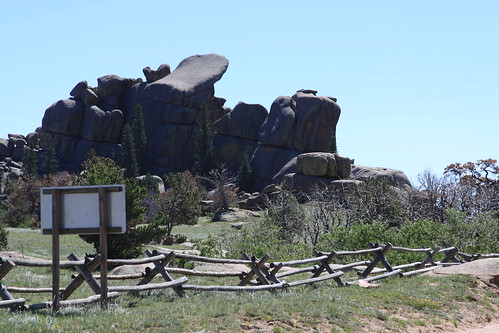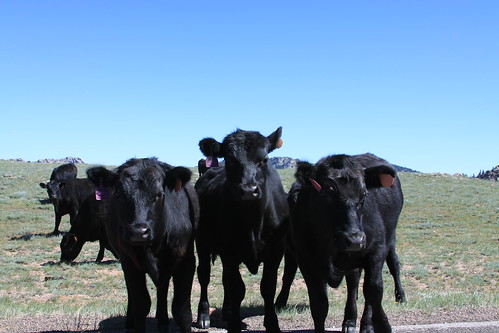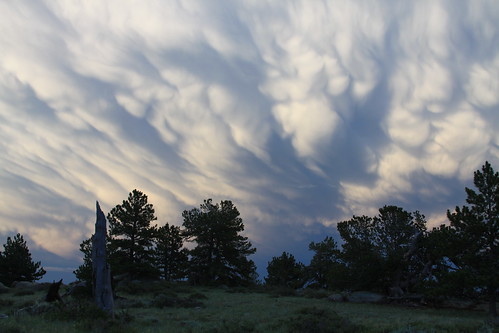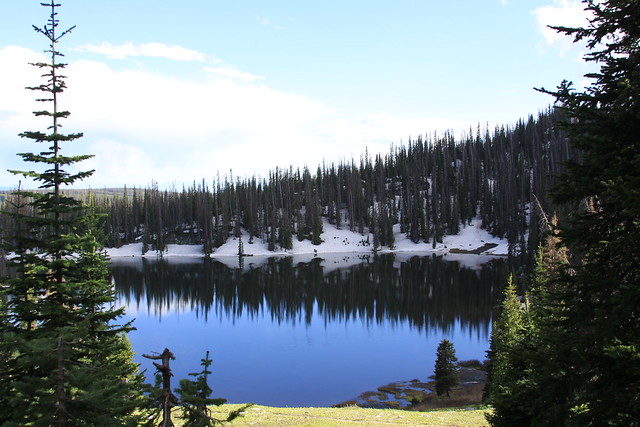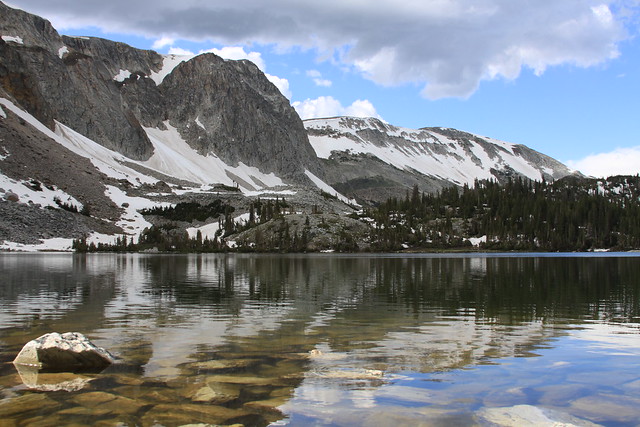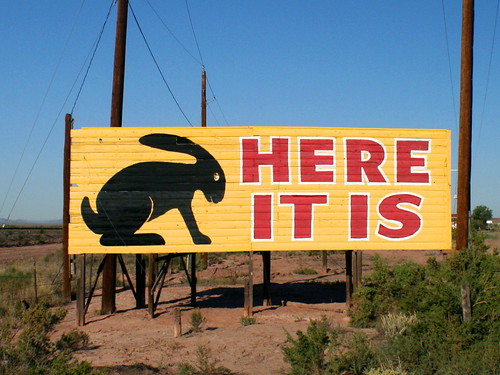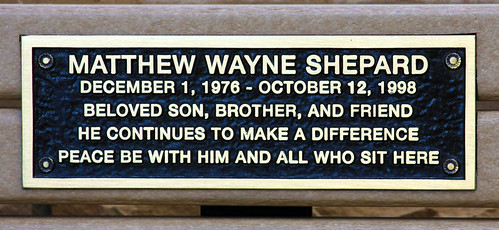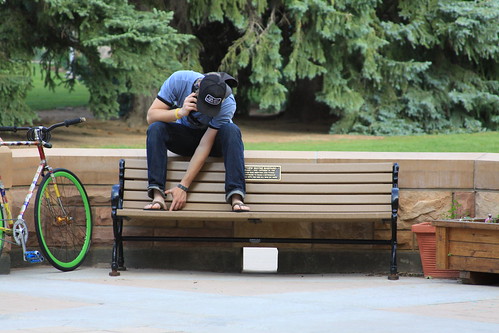One thing I constantly have to remind myself when I come home is that the Rockies run on a different set of rules from everything else. The pace of life is different, for one. In the winter, the tempo of existence depends completely on the weather, so one makes plans and travels over several days. When the snow started here last night, everything ground to a slow halt, and we sit with friends and drink coffee and "bullshit" each other, as my mother Goose might say. When the roads melt off and all are ploughed, the pace of life will quicken back up to a regular, but still lazy pace. Those differences stand out more and more every Christmas I go back and try to pick up the rhythms again.
For instance, my parents and I headed out to the grocery store, but they stopped by the old A&W to grab a cup of coffee first. A bunch of people that my Papa Fox knows all meet for coffee twice a day-- 9AM and 3 PM-- and they come religiously. We piled out of the car in the parking lot, and my father left the car unlocked and running while we sat. Mama Goose introduced me to one of her friends and her son. The server brought out the coffee pot and filled us all up. My mother pulled out a twenty to pay for the coffee and promptly got the stinkeye.
"I'm ignoring you," the server said to my mother.
"What, my money's not good enough for you?" Mama Goose asked with a grin. The server sniffed at it.
"Stinks," she answered. My mom scoffed and put her money back. So, we all got free coffee as we talked, and that restaurant owner got to show her unusual brand of appreciation to her regular customers and loyal friends. The small business owners don't always focus on the bottom line, it seems; things run different out here.
Also, did you know that not every person in this country has to get searched to get on a passenger plane? Not to mention carriers or locations, but when we brought my grandfather in late at night to board his flight back to Montana, the TSA agent had already been sent home and the only passenger coming in for hours was old Grampa Wolf. The agent for the flight took and scanned his bags, walked him by hand to the gate, and took him through a side door out to the plane, no pat downs or anything. We gave him a hug right in front of the only gate in the airport, and out he went, without ever entering the secure boarding area first.
I'm sure that there's someone out there who'd freak out at the thought of an unsearched person boarding a plane, but around here it makes a lot of sense. They were picking up a single traveler, an 87 year-old man who caught the very last flight out. The plane had no connections to anywhere else and only twelve minutes to get back in the air. There might be two TSA agents in the county, so why keep them there for another three hours to search one person with no carry-on bags? He was in no danger of entering the larger flight system, and once his ID was verified and his bags checked, there was no reason to make an old man with bad balance and Padgett's disease completely undress for a hand search. We just do things different here.
So, why such a nonchalant way of relating to others? I suppose what really makes things different is that there are no strangers...
Calling all Theater companies and performers!
Open Call to Theater companies, performers, researchers:
I would like to hear other voices besides my own on this blog. If you'd like to write about your TLP experiences here, e-mail them to me and I'll put them up.
Topics can include dramaturgy to staging to personal responses to the play. Anything goes!
I would like to hear other voices besides my own on this blog. If you'd like to write about your TLP experiences here, e-mail them to me and I'll put them up.
Topics can include dramaturgy to staging to personal responses to the play. Anything goes!
Thursday, December 30, 2010
Wednesday, December 29, 2010
This is how Wyoming field trips happen.
Well, after a brown Christmas, I finally made it to my parents' house in Wyoming a few days ago from Casper. My grandpa Wolf was down here for a few days, and we drove to a town with an airport to fly him back home to Montana. After the flight took off, however, the airport decided that the runway was too slick to land a plane on, and so my 87 year-old, crotchety, snappish, OCD grandfather had to spend the night with four other passengers in Billings, MT.
So, now it's the next day, and northern Montana is supposed to get slammed with all our late Christmas snow by 3 PM. So, with the blizzard bearing down upon them, the airline tried to sneak them all back into Lewistown before the snow hit. They packed my old Grampa Wolf up onto a plane, circled the Fergus County airport five and a half times, and had to turn back. Only, now Billings is too nasty to land, so he's been diverted. To Sheridan, Wyoming. In the northeastern corner of the state.
Oh, la. So, my mother's hair is standing on end, and Papa Fox and I are debating whether or not it's worth tromping through Ten Sleep Canyon to try and snatch him up before the snow heads south. Either way, we'll be driving through snowstorm by six o'clock.
At the moment, it looks like Papa Fox and Jackrabbit will be headed out to outrun the storm, so wish us luck! I've wanted to see the Bighorn Mountains for quite a long time-- but I just didn't want to see it with four inches of snow on the ground...
[Update...]
Well, just as we were about to head out the door and scream down the road towards Sheridan, my mother finds out that the airplane isn't staying in Sheridan. It's heading back to Billings, where they couldn't land before but now they can, and they had a 20-minute window to get him home.
Naturally, they missed the window of clear weather. That means that, after a full day of travel to three different destinations in two states, Grampa Wolf is back in Billings, at the same hotel he had left that morning. Outside my window, the snow falls in thick, thick cushions over everything in sight.
Grab the hot cocoa and kick back, Grampa. I don't think you (or any of us) are going anywhere soon...
So, now it's the next day, and northern Montana is supposed to get slammed with all our late Christmas snow by 3 PM. So, with the blizzard bearing down upon them, the airline tried to sneak them all back into Lewistown before the snow hit. They packed my old Grampa Wolf up onto a plane, circled the Fergus County airport five and a half times, and had to turn back. Only, now Billings is too nasty to land, so he's been diverted. To Sheridan, Wyoming. In the northeastern corner of the state.
Oh, la. So, my mother's hair is standing on end, and Papa Fox and I are debating whether or not it's worth tromping through Ten Sleep Canyon to try and snatch him up before the snow heads south. Either way, we'll be driving through snowstorm by six o'clock.
At the moment, it looks like Papa Fox and Jackrabbit will be headed out to outrun the storm, so wish us luck! I've wanted to see the Bighorn Mountains for quite a long time-- but I just didn't want to see it with four inches of snow on the ground...
[Update...]
Well, just as we were about to head out the door and scream down the road towards Sheridan, my mother finds out that the airplane isn't staying in Sheridan. It's heading back to Billings, where they couldn't land before but now they can, and they had a 20-minute window to get him home.
Naturally, they missed the window of clear weather. That means that, after a full day of travel to three different destinations in two states, Grampa Wolf is back in Billings, at the same hotel he had left that morning. Outside my window, the snow falls in thick, thick cushions over everything in sight.
Grab the hot cocoa and kick back, Grampa. I don't think you (or any of us) are going anywhere soon...
Saturday, December 25, 2010
Merry Christmas from Jackrabbit
Okay, so it's time for a cessation in all this Festivus angst and spread a little more holiday cheer. Since I haven't really had much of a chance to take some good, wintery photos yet while I'm back in Wyoming, I culled some of my best of the previous year for you. So, wrap up, grab some hot chocolate, and enjoy the winter chill compliments of Jackrabbit.
To give credit where credit's due, these pictures are a mixture of shots taken both by me and my talented niece Kestrel. She's really quite remarkable. For a hint, most of the really good ones are hers.
Merry Christmas, Happy Holidays, and be blessed, y'all. Love is born this season.
To give credit where credit's due, these pictures are a mixture of shots taken both by me and my talented niece Kestrel. She's really quite remarkable. For a hint, most of the really good ones are hers.
Merry Christmas, Happy Holidays, and be blessed, y'all. Love is born this season.
Thursday, December 23, 2010
The Airing of Grievances, Charge 2
Being the First Part,
Regarding the Straw and the Plank
Regarding the Straw and the Plank
A couple of years ago, my Ph. D program requirements led me to take a class on composition and ethnography with our program director. Part of the requirements of the class was to do a short qualitative analysis on some kind of literacy topic, and if there's one thing I've figured out from going through the rigmarole of IRB supervision and preparing for a qualitative study, it's that you should always distrust the self.
That may sound paranoid, but it makes a lot of sense for a discipline that requires the researcher to observe and interact with people or cultures. If you are an outsider, you might have different values or ways of understanding that hamper your ability to understand what's valuable or important in the culture you study. You might not know what to look for beneath the surface. If you grew up with the people or cultures you're studying, however, sometimes that can give you blind spots or make you reluctant to draw negative conclusions. Both of these possibilities require the researcher to stop, look at their own motives and cultural values, and understand that those worldviews or personal experiences will color their observations.
Hell, let's be honest-- the first nine months of this blog were basically just a really, really long bracketing interview to hash out my motives for studying this play. The last thing I can do is just assume that I've got it all figured out and that I'm completely on the clear because I never am. I always have motives. I always have to accept that objectivity is impossible for me due to my personal connection to the play and events, and the best I can do is to mistrust my own conclusions and force myself to look at all the angles. And I will still screw up.
And so, how does this apply to Tectonic Theater? Some of them (like Stephen Belber) show themselves to be pretty ambivalent and angsty about this process, and boy, do I appreciate that; it means they're concerned about their relationship to their interviewees. Nevertheless, I think that, as a company, sometimes they believe in their mission so much that they just know what they're doing is the right thing. That's where maybe they slipped up a little when it came to giving a full, well-rounded portrayal of Laramie: they immediately saw the right answer and ran with it.
And so, I would like to proceed to the second charge in the Airing of Grievances, which is related to the first:
2. Failure to Maintain Self-Loathing
Okay, so that's a little harsh, but "Failure to Maintain Self-Referentiality" or "Failure to Bracket" just sounded too academic. Basically, I'm just saying that maybe they believed in their mission a little too much or didn't stay suspicious enough of their own motives to question if they were getting too focused on the wrong thing. So, here we go, and let's see what we find-- just remember, ladies and gents, to keep a healthy self-doubt about your view of western culture and Tectonic's motives, too!
* * *
Labels:
ambivalence,
faith,
GLBT,
Laramie,
Tectonic Theater,
The Grievances,
theater,
Wyoming
Monday, December 20, 2010
Life among the prairie parishes: Time reports
When my grandmother was born in Garniell, Montana during the Depression, she lived on a farm; the nearest actual town was Judith Gap, in the middle of the Montana breadbasket, and the nearest church was therefore about ten miles away. Her family had a choice of driving to Moore and be a Catholic or Methodist or go to the Gap... and be Catholic or Methodist. The nearest town with any other denominations were all the way in Lewistown. My grandfather grew up on the other side of the Gap in a staunch Lutheran family. I think they went to the Methodist church.
These tiny parish churches and prairie chapels were sometimes a county apart and had only a handful of families in attendance. Now, their numbers are shrinking as those families commute for services or stop going altogether.
Time ran this interesting short piece about the traveling pastors who serve these tiny farming communities in Minnesota. Apparently Blogger isn't fond of flash videos, but this displays remarkably well in full-screen if you choose. In any case, the plight of these pastors is very similar to what we see in Montana and Wyoming as well...
These tiny parish churches and prairie chapels were sometimes a county apart and had only a handful of families in attendance. Now, their numbers are shrinking as those families commute for services or stop going altogether.
Time ran this interesting short piece about the traveling pastors who serve these tiny farming communities in Minnesota. Apparently Blogger isn't fond of flash videos, but this displays remarkably well in full-screen if you choose. In any case, the plight of these pastors is very similar to what we see in Montana and Wyoming as well...
Saturday, December 18, 2010
Good Riddance, DADT...
 |
| Photography by Jason Pier, at: www.jasonpier.com. |
Was this a "Hail Mary pass" like the Washington Post said? Sure it was. The bill is less than two weeks old. Does the bill contain some compromises? Yes. But, when the smoke cleared, the decision that most people could see was the right conclusion happened.
What I find especially interesting, however, is how the news sites are covering the vote. For two examples, you can see CNN and Fox News' coverage at the two links above. I especially like how each of them frames the names of the eight Republican senators who voted for the measure.
I'm sad about the DREAM Act and that Republicans are too worried about the "message" the bill sends to make a humanitarian gesture to kids who didn't have any choice over coming to the States legally. But, hey, I'll take progress where I can get it!
Oh, and I'm typing this post less than ten feet from my in-laws, who very much don't support the repeal. Especially my ex-Marine father-in-law, who means well but can only compare Marine culture to his own experience in the sixties and seventies. I don't think he understands how much of a non-issue this is for my generation and younger. Yay, fun!
PHOTO CREDIT: Jason Pier, who provided this photo via a Creative Commons License. You can see his entire Flickr photostream here.
Tuesday, December 14, 2010
Remember to always drink responsibly, boys and girls...
Most of the time, I really love living in the South-- well, at least this part of the South. But every once in a while I see something that just sets my rage a-flaming. You know, like this:
So I go to pick up my prescriptions this afternoon, and this is what I run into-- a freaking drugstore serving forties and ping pong balls together in the same cooler. It wasn't like it was just the one spot, either-- every other door had a hanging display of em'. Nothing says encouraging responsible alcohol use on my party campus and the high school three blocks down the street quite like one-stop shopping for all your beer pong needs.
You can't blame this on just this CVS, however. The drugstore three blocks down the road is a Wallgreen's, and they do the same thing. Ladies and gentlemen, I don't want to say that this is the reason for the alcohol abuse culture I see with my students... but it sure ain't helping.
So I go to pick up my prescriptions this afternoon, and this is what I run into-- a freaking drugstore serving forties and ping pong balls together in the same cooler. It wasn't like it was just the one spot, either-- every other door had a hanging display of em'. Nothing says encouraging responsible alcohol use on my party campus and the high school three blocks down the street quite like one-stop shopping for all your beer pong needs.
You can't blame this on just this CVS, however. The drugstore three blocks down the road is a Wallgreen's, and they do the same thing. Ladies and gentlemen, I don't want to say that this is the reason for the alcohol abuse culture I see with my students... but it sure ain't helping.
Labels:
lol,
miscellaneous rant,
The South
Monday, December 13, 2010
Links: Morning Has Broken- Una Vita Spezzata
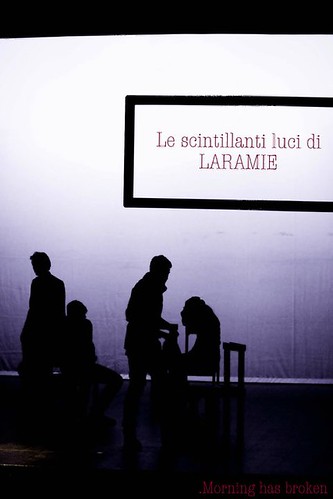
Well, it seems as if my Flickr ticker on the blog has yielded another loose Laramie narrative running free, this time in Italy. The photo you see here (and which showed up on my blog a couple weeks ago) is from a concept performance called Moring Has Broken- Una Vita Spezzata, which debuted in Firenze, Italy back in November around the same time that we were having Thanksgiving back stateside. The performing company described it as a "reportage" moments and excerpts from both The Laramie Project and Judy Shepard's book The Meaning of Matthew.
As you can see from the photo at left, the staging is extremely minimalistic, it focuses on the abstract, and... well, it's in Italian. (If my Latin doesn't fail me, that sign says "The shining lights of Laramie.) Unfortunately, I can't find any information about the content or staging of the performance, so I can't really speculate about the content. I'm fairly intrigued, however, by the idea. By calling this a "reportage" they claim to be relaying news in an abstract sense, but their main texts are a memoir and a play. So, if anything, it's a reportage of first-hand accounts, creatively rethought. I wish I could find a little video clip of this, but there's nothing up on that, either.
There are, however, some nice stills of the performance if you want to get a sense of it. You can view most of the set on a Flickr Photostream here, including a poster for the event, but if you're the sort that prefers your Internet searching to have a soundtrack, someone involved with the production set them up as a slide show with some old school Cat Stevens as a YouTube video.
And, there is contact information via a Facebook event if you'd like more information here (and have better Italian skills than I do.)
Labels:
links,
Matt Shepard,
theater
Friday, December 10, 2010
The Airing of Grievances, Charge 1
As it turns out, my brother Coyote, who still lives in Laramie, also has an angsty relationship with The Laramie Project. I had already sort of known this, of course; both he and my sister were living in Laramie back in 1998, too, and back in my "I hate this freaking play" phase in the Deep South, he and I had a few conversations about that.
But until this summer, I thought that his complaints just stemmed from his own personal knowledge of the incident. Coyote, you see, knew both of the killers and Matt Shepard through various channels even though he didn't have any kind of deep relationship with any of them. He was much better friends with "Sascha" and several other members of the LGBTA on campus. And, since our conversations had mostly revolved around that social set, I had always thought that his main gripe against the play was just the "accuracy" issue.
As it turns out, though, I was wrong; his dislike was more complicated than I had given him credit for. Over dinner one night at a fancy bar and grill (where I was buying him his obligatory steak dinner), Coyote told me that he had watched the HBO version of the play and had some extremely pointed comments about its message. He said he didn't like what the HBO version had to say about what Laramie was like as a community, and he didn't think that the message had any balance. He was also surprised that I didn't completely disagree with him. "On the whole, though, don't you think this play has done some good nationwide?" I asked him. "I mean, people are actually willing to talk about issues like this now..."
And so, I hereby must proceed to the airing of my first grievance in this Festivus season:
Or, I could call it "Transporting an Underage Story Across State Lines," I suppose. The point is this: in disseminating this story, Tectonic has left many in Laramie feeling like they have no control over their own identities, leaving some people to feel vulnerable or exposed, a point I've discussed before. That may not necessarily be a bad thing, but let's work out the details to see where it leads...
But until this summer, I thought that his complaints just stemmed from his own personal knowledge of the incident. Coyote, you see, knew both of the killers and Matt Shepard through various channels even though he didn't have any kind of deep relationship with any of them. He was much better friends with "Sascha" and several other members of the LGBTA on campus. And, since our conversations had mostly revolved around that social set, I had always thought that his main gripe against the play was just the "accuracy" issue.
As it turns out, though, I was wrong; his dislike was more complicated than I had given him credit for. Over dinner one night at a fancy bar and grill (where I was buying him his obligatory steak dinner), Coyote told me that he had watched the HBO version of the play and had some extremely pointed comments about its message. He said he didn't like what the HBO version had to say about what Laramie was like as a community, and he didn't think that the message had any balance. He was also surprised that I didn't completely disagree with him. "On the whole, though, don't you think this play has done some good nationwide?" I asked him. "I mean, people are actually willing to talk about issues like this now..."
"Well, sure, yeah," Coyote said. "I can totally see where this play has done a lot of good. But, come on, Jackrabbit-- why did we have to be the ones to pay for it?"
"So, you mean you feel like telling Laramie's story comes at a cost?" I asked him.
"Hell yeah," He answered through a mouthful of steak. "This sort of thing happens all over the country, but I don't see any of them having to relive this story every time somebody puts on a play." He waved his fork at me for emphasis. "We can't escape it. We can't even answer back to it. How fair is that?"I couldn't keep my jaw off of the floor when he said that. I had sort of been wondering the same thing for months: does the simple fact of telling Matt's story in the context of this community cause social damage? Like Coyote, I know the kind of social good this play has engendered on the macro scale; but I also wonder, like him, what kind of unintended cost the microcosm of Laramie has had to absorb as a result.
And so, I hereby must proceed to the airing of my first grievance in this Festivus season:
1.Contributing to the Delinquency of Narrative
Or, I could call it "Transporting an Underage Story Across State Lines," I suppose. The point is this: in disseminating this story, Tectonic has left many in Laramie feeling like they have no control over their own identities, leaving some people to feel vulnerable or exposed, a point I've discussed before. That may not necessarily be a bad thing, but let's work out the details to see where it leads...
Labels:
ambivalence,
community,
identity,
memory,
narrative,
The Grievances,
The Laramie Project
Tuesday, December 7, 2010
Laramie in Pictures: Vedauwoo and Ames Monument
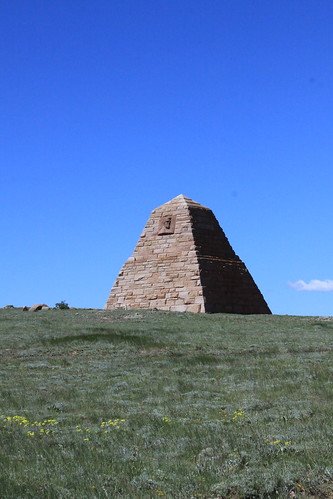 |
| Where have all the railroads gone? asks the Ames monument... |
Vedauwoo is one of my favorite places because of its strange geologic architecture. The bright pink granite that makes up most of the range between Cheyenne and Laramie is stacked up in these massive, huge boulders which attract rock climbers from all over the nation. It's a popular camping, recreation, and picnic spot for the UW students. In the dusk, the landscape looks almost mystical.
Ames Monument is a stranger, more enigmatic spot. A three minutes' ride down a rose-colored gravel road and through a horse pasture will lead you to a massive pyramid built out in the middle of nowhere, a monument to the wealth and influence of the Union Pacific Railroad financiers Oakes and Oliver Ames (two brothers, and rather shady figures.) Oakes was eventually censured by Congress for fraud and died in disgrace.
The monument to Oakes and Oliver Ames was built to mark the highest point of the UP transcontinental railroad lines, which were then promptly moved elsewhere; the monument therefore now stands alone, marking the point of an amazing accomplishment now tarnished by corruption and diminished by the Interstate system. For decades it has sat undisturbed near an abandoned town, but there are signs of development nearby now-- a possible high-end subdivision, it looks like. (blech.) It seems like no patch of land is safe from breaking out in residential, picket-fenced pimples anymore.
Anyhow, here are a few pictures I took (and a couple I didn't) of these two strange, mythical spots on the edge of the Laramie landscape!
The weather erodes the pink Sherman granite into the most strange shapes, as seen here.
I wanted to show you the larger stuff, but I didn't have time to venture far into the park. So, here are two pictures from Flickr to give you the feel:
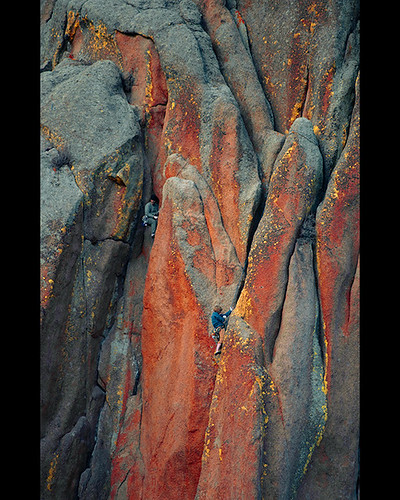 |
| Photo by Coulter Sunderman, via Flickr. I'm jealous... |
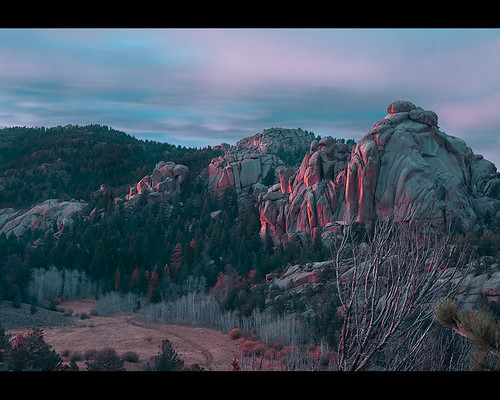 |
| This one's also by Coulter Sunderman, from Flickr. This might be my favorite photo I've seen. |
As with a lot of public lands, the areas outside Vedauwoo are often rented for pasture. Here's a trio of Angus bullocks who came to check me out as I drove to the entrance...
And here are two views of the Ames monument for you:
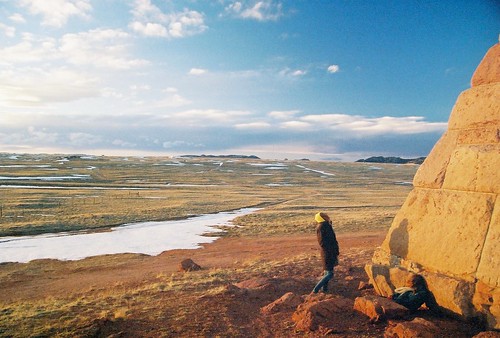 |
| This one comes from Lord the air smells good today's Flickr photostream. (I just love that name.) |
I'd like to give a special shout out to both Coulter Sunderman and Lord the Air Smells Good Today for sharing their photos via Creative Commons. Thanks!
Labels:
In Pictures,
landscape,
Laramie,
Vedauwoo
Monday, December 6, 2010
Oh, Manhattan Declaration, you unruly thing...
Good grief, Steve Jobs, do not make me have to stick up for the freaking Manhattan Declaration...
Okay, so CNN's Belief blog is reporting that Apple had removed the Manhattan Declaration's app for iPhone from their app store, citing complaints about the offensiveness of the content. (Well, gee, I never would have seen that one coming.) The main issue, it seems, is a quiz you can have your friends take to show your Manhattan awesomeness or something by asking if you're against gay marriage and whatnot.
Supporters of the Manhattan Declaration, naturally, are pitching a fit. Oh, and they've also started a petition, as it turns out. Right now it's only got about 40,000 signers, so it might go somewhere.
Maybe.
Okay, so on a serious note, I really don't like this due to the issues of free religious speech surrounding it. Sure, I don't care for the Manhattan declaration one bit. (you can see me rant about it even more here and here.) But this is dealing with speech specifically protected by the Constitution. Besides, the App store has tons of religious apps, from a compass that will help me determine the direction of Mecca to Ba'hai commentaries to a complete Catholic liturgy I can run on my iPod (I almost bought that, actually.) Some of the apps I see in this category I find just as annoying as the Manhattan Declaration. So, why single out an app that's specifically designed to be a free declaration of a person's beliefs about their faith and its intersections with culture? (Well, it's a squeaky wheel issue, of course. That's a rhetorical question I guess.)
Apple Inc. has never really shown itself to be a huge proponent of free speech-- rather, they are usually more proponents of huge profits, and in order to do that, they tend not to stir the muck. Sure, I didn't complain too much when they discontinued the "Wobble" app and limited other sexually explicit content. But then again, there wasn't such a clear component of protected speech about that one, either. Apple reserves the right to oust content they determine to be "widely offensive," but, come on-- stating one's moral opposition is not inherently offensive. And I'm even saying that as a strong opponent of the MD who has read the thing.
And so, I find myself in a strange position now. I'm all for free speech. I'm especially for free religious expression, whether I like what others have to say or not. On the one hand, Apple is a private corporation and they have the right to police content. On the other hand, they are the only way to get apps onto an iPhone. Their decision to discontinue, then, really moves into the realm of digital censorship at that point, and in my mind, that's where things get sticky.
So, based on my personal beliefs... do I really have to stick up for the Manhattan Declaration??!? Blech. I'd feel like such a hypocrite...
Okay, so CNN's Belief blog is reporting that Apple had removed the Manhattan Declaration's app for iPhone from their app store, citing complaints about the offensiveness of the content. (Well, gee, I never would have seen that one coming.) The main issue, it seems, is a quiz you can have your friends take to show your Manhattan awesomeness or something by asking if you're against gay marriage and whatnot.
Supporters of the Manhattan Declaration, naturally, are pitching a fit. Oh, and they've also started a petition, as it turns out. Right now it's only got about 40,000 signers, so it might go somewhere.
Maybe.
Okay, so on a serious note, I really don't like this due to the issues of free religious speech surrounding it. Sure, I don't care for the Manhattan declaration one bit. (you can see me rant about it even more here and here.) But this is dealing with speech specifically protected by the Constitution. Besides, the App store has tons of religious apps, from a compass that will help me determine the direction of Mecca to Ba'hai commentaries to a complete Catholic liturgy I can run on my iPod (I almost bought that, actually.) Some of the apps I see in this category I find just as annoying as the Manhattan Declaration. So, why single out an app that's specifically designed to be a free declaration of a person's beliefs about their faith and its intersections with culture? (Well, it's a squeaky wheel issue, of course. That's a rhetorical question I guess.)
Apple Inc. has never really shown itself to be a huge proponent of free speech-- rather, they are usually more proponents of huge profits, and in order to do that, they tend not to stir the muck. Sure, I didn't complain too much when they discontinued the "Wobble" app and limited other sexually explicit content. But then again, there wasn't such a clear component of protected speech about that one, either. Apple reserves the right to oust content they determine to be "widely offensive," but, come on-- stating one's moral opposition is not inherently offensive. And I'm even saying that as a strong opponent of the MD who has read the thing.
And so, I find myself in a strange position now. I'm all for free speech. I'm especially for free religious expression, whether I like what others have to say or not. On the one hand, Apple is a private corporation and they have the right to police content. On the other hand, they are the only way to get apps onto an iPhone. Their decision to discontinue, then, really moves into the realm of digital censorship at that point, and in my mind, that's where things get sticky.
So, based on my personal beliefs... do I really have to stick up for the Manhattan Declaration??!? Blech. I'd feel like such a hypocrite...
Labels:
ethics,
faith,
GLBT,
links,
Manhattan Declaration
Friday, December 3, 2010
The Airing of Grievances
Ah, Festivus.
 To be honest, my family was acquainted with its own version of that holiday long before Seinfeld ran with it on their sitcom, but in my family we called it by traditional names like "Thanksgiving" or "Christmas." In my family, holidays have never been a source of joy and conviviality, but rather, something much more closely akin to what George Costanza's father had in mind, with feats of strength and the all-important airing of grievances.
To be honest, my family was acquainted with its own version of that holiday long before Seinfeld ran with it on their sitcom, but in my family we called it by traditional names like "Thanksgiving" or "Christmas." In my family, holidays have never been a source of joy and conviviality, but rather, something much more closely akin to what George Costanza's father had in mind, with feats of strength and the all-important airing of grievances.
The Jackrabbit family has always rigorously observed the Airing of Grievances at holiday gatherings and (for some reason peculiar to us) especially Thanksgiving. There's something about the tryptophan in turkey and the close proximity to each other that makes my relatives feel like it's a good time to explain to each other exactly how we're screwing up each others' lives. This has always made for a lively Thanksgiving: food, festivity, and, after a few beers and a bottle or two of wine, fireworks.
At this point, The Laramie Project feels like family, too, but more in that Married with Children sense of "family" than The Waltons, which is fine with me; my real family is more like Married with Children anyhow. My relationship to the play is a little dysfunctional, a little codependent, and definitely just a tad hostile; conversely, if anybody else bashes them, I get righteously pissed. In my family, that means you love each other, so... I guess that means I love Tectonic Theater. Welcome to the family, guys. Pull up a chair and pass the gravy.
After blogging on The Laramie Project for so many months now, I feel like I'm finally able to tease out some of the knotty spots regarding my relationship to this play. I can now say truthfully (and with much relief) that I don't hate this play or Tectonic Theater. I can also say that my ambivalence for the play has stemmed from a lot of issues, not because Tectonic Theater did something wrong, but usually because they did so many things right. The play makes me angsty and hostile because it seriously challenges my identity in ways I don't always think are fair, but are nevertheless important for social growth. In some ways, my relationship is a lot like a hostile teenager to a confrontational mentor: I'll grow up and develop into an ethical citizen working for a just society because of you, but I'm still going to resent it. So there. Nyah.
I've been spending a lot of time talking about the social good that this play can do, like in my one-and-only academic conference paper on The Laramie Project. And, except for couple notable exceptions, every time that I think that I've had a genuine complaint against what Tectonic Theater had done, I eventually realize that I haven't considered things completely and that I don't really have a complaint after all. Up to this point, I could point to complications, but not genuine problems once I understood the nuance of the situation, so all I had left was sunshine and rainbows.
Well, I suppose until now, that is. There are a few nagging questions I've had running around in my head for at least five months, and I think it's about time I address them now. I've long since raised my blogosphere Festivus pole. It's time, now that I've had my Feats of Strength sparring with this play and gotten this dysfunctional family around the proverbial dinner table, that we must finally have the Airing of Grievances.
In a way, I feel like coming to this point represents a genuine breakthrough with my relationship with The Laramie Project because I can appreciate it for both its strengths and weaknesses without feeling that they define who I am, too. I can also approach it with some critical distance while appreciating all the good they've done.
The play has created amazing moments of social reform because of its unpredictable power-- but that unrestrained power has caused a lot of damage, too. It's like getting radiation therapy: Tectonic Theater identified a terrible social cancer and started attacking it, but they also damaged the surrounding tissues in the process, agitated the body as a whole. And in a real sense, you have to take the bad with the good; you can't stop showing The Laramie Project because of the unpredictable consequences. Yet, you still have to recognize that those problems are there, and that their effects are very real. I feel we need to have an airing of grievances so that we can realize what is truly at stake with social theater as radical and powerful as The Laramie Project. If you're trying to be an earthquake like Tectonic Theater and you shake things up... well, you have to take responsibility for the cracks in the foundations afterward, for the broken earth and shattered windows.
So that's my plan with my next several posts: I am going to be extremely honest about individual areas where I feel like Tectonic has caused a little unintentional social damage or maybe misunderstood their role in the process of bringing Laramie's story into the spotlight. Some of these grievances will be fair, and maybe others won't. Mostly, I want to be extremely honest about what the consequences of those problems might be-- not so that I can judge the play for the damage, but so that we can have a fuller idea of the power and potential of social theater to enact change, be it life-changing in a positive or a catastrophic way.
So: Let the Airing of Grievances begin!
PHOTO CREDIT:
1) A Festivus card, from "teh Internets." I've seen this in a lot of places and don't know who to attribute. If it's yours, feel free to let me know and I'll attribute you!
2) Earthquake damage in Seattle, 1949, from the Seattle Municipal Archives on Flickr. Available under a Creative Commons License.
 To be honest, my family was acquainted with its own version of that holiday long before Seinfeld ran with it on their sitcom, but in my family we called it by traditional names like "Thanksgiving" or "Christmas." In my family, holidays have never been a source of joy and conviviality, but rather, something much more closely akin to what George Costanza's father had in mind, with feats of strength and the all-important airing of grievances.
To be honest, my family was acquainted with its own version of that holiday long before Seinfeld ran with it on their sitcom, but in my family we called it by traditional names like "Thanksgiving" or "Christmas." In my family, holidays have never been a source of joy and conviviality, but rather, something much more closely akin to what George Costanza's father had in mind, with feats of strength and the all-important airing of grievances.The Jackrabbit family has always rigorously observed the Airing of Grievances at holiday gatherings and (for some reason peculiar to us) especially Thanksgiving. There's something about the tryptophan in turkey and the close proximity to each other that makes my relatives feel like it's a good time to explain to each other exactly how we're screwing up each others' lives. This has always made for a lively Thanksgiving: food, festivity, and, after a few beers and a bottle or two of wine, fireworks.
At this point, The Laramie Project feels like family, too, but more in that Married with Children sense of "family" than The Waltons, which is fine with me; my real family is more like Married with Children anyhow. My relationship to the play is a little dysfunctional, a little codependent, and definitely just a tad hostile; conversely, if anybody else bashes them, I get righteously pissed. In my family, that means you love each other, so... I guess that means I love Tectonic Theater. Welcome to the family, guys. Pull up a chair and pass the gravy.
After blogging on The Laramie Project for so many months now, I feel like I'm finally able to tease out some of the knotty spots regarding my relationship to this play. I can now say truthfully (and with much relief) that I don't hate this play or Tectonic Theater. I can also say that my ambivalence for the play has stemmed from a lot of issues, not because Tectonic Theater did something wrong, but usually because they did so many things right. The play makes me angsty and hostile because it seriously challenges my identity in ways I don't always think are fair, but are nevertheless important for social growth. In some ways, my relationship is a lot like a hostile teenager to a confrontational mentor: I'll grow up and develop into an ethical citizen working for a just society because of you, but I'm still going to resent it. So there. Nyah.
I've been spending a lot of time talking about the social good that this play can do, like in my one-and-only academic conference paper on The Laramie Project. And, except for couple notable exceptions, every time that I think that I've had a genuine complaint against what Tectonic Theater had done, I eventually realize that I haven't considered things completely and that I don't really have a complaint after all. Up to this point, I could point to complications, but not genuine problems once I understood the nuance of the situation, so all I had left was sunshine and rainbows.
Well, I suppose until now, that is. There are a few nagging questions I've had running around in my head for at least five months, and I think it's about time I address them now. I've long since raised my blogosphere Festivus pole. It's time, now that I've had my Feats of Strength sparring with this play and gotten this dysfunctional family around the proverbial dinner table, that we must finally have the Airing of Grievances.
In a way, I feel like coming to this point represents a genuine breakthrough with my relationship with The Laramie Project because I can appreciate it for both its strengths and weaknesses without feeling that they define who I am, too. I can also approach it with some critical distance while appreciating all the good they've done.
The play has created amazing moments of social reform because of its unpredictable power-- but that unrestrained power has caused a lot of damage, too. It's like getting radiation therapy: Tectonic Theater identified a terrible social cancer and started attacking it, but they also damaged the surrounding tissues in the process, agitated the body as a whole. And in a real sense, you have to take the bad with the good; you can't stop showing The Laramie Project because of the unpredictable consequences. Yet, you still have to recognize that those problems are there, and that their effects are very real. I feel we need to have an airing of grievances so that we can realize what is truly at stake with social theater as radical and powerful as The Laramie Project. If you're trying to be an earthquake like Tectonic Theater and you shake things up... well, you have to take responsibility for the cracks in the foundations afterward, for the broken earth and shattered windows.
So that's my plan with my next several posts: I am going to be extremely honest about individual areas where I feel like Tectonic has caused a little unintentional social damage or maybe misunderstood their role in the process of bringing Laramie's story into the spotlight. Some of these grievances will be fair, and maybe others won't. Mostly, I want to be extremely honest about what the consequences of those problems might be-- not so that I can judge the play for the damage, but so that we can have a fuller idea of the power and potential of social theater to enact change, be it life-changing in a positive or a catastrophic way.
So: Let the Airing of Grievances begin!
PHOTO CREDIT:
1) A Festivus card, from "teh Internets." I've seen this in a lot of places and don't know who to attribute. If it's yours, feel free to let me know and I'll attribute you!
2) Earthquake damage in Seattle, 1949, from the Seattle Municipal Archives on Flickr. Available under a Creative Commons License.
Tuesday, November 30, 2010
Some Short Creative Nonfiction from RBU
In Appalachia's blank winter skies and endless rain at the end of this November, I find myself longing for stars and family. This is a piece I wrote for Real Bloggers United some months ago and find myself revisiting, so I thought I'd share it.
Starlight Requiem
God is an intelligible Sphere whose centre is everywhere and whose circumference is nowhere.
 And yet, when I was a child living in a house of science, my childhood cathedral was dominated by the turning of the spheres and I never knew it. You see, star watching guides don’t talk about the motion of the earth around the sun—they talk about the night sky and sun revolving eternally around the horizon line, with Polaris its hub and the constellations churning about in their various declinations. The stock-still earth served as my kneeling-bench as I gazed up, up, into the rood-loft of the night and learned the names of the stars in the Northern Cross in almost the same way that a medieval priest might have taught his flock the names of the Patriarchs whose lives were painted on the walls. In my head, I knew that the earth turned around the sun; but in the deep recesses of my imagination, God’s stars and His sun turned inexorably around the earth.
And yet, when I was a child living in a house of science, my childhood cathedral was dominated by the turning of the spheres and I never knew it. You see, star watching guides don’t talk about the motion of the earth around the sun—they talk about the night sky and sun revolving eternally around the horizon line, with Polaris its hub and the constellations churning about in their various declinations. The stock-still earth served as my kneeling-bench as I gazed up, up, into the rood-loft of the night and learned the names of the stars in the Northern Cross in almost the same way that a medieval priest might have taught his flock the names of the Patriarchs whose lives were painted on the walls. In my head, I knew that the earth turned around the sun; but in the deep recesses of my imagination, God’s stars and His sun turned inexorably around the earth.
PHOTO CREDIT:
1) Night Sky (Wish you were here Andreas) by Indian.summer 1901's Flickr photostream:
Starlight Requiem
God is an intelligible Sphere whose centre is everywhere and whose circumference is nowhere.
-- Alan of Lille
* * *
This is my Father's world,
And to my listening ears,
All nature sings, and round me rings
the music of the Spheres...
“What’s wrong?” My then-boyfriend asked me when I stopped singing. I turned to face him with a frown.
“The ‘music of the spheres?’” I said over the noise of the worship service. “That’s so anachronistic. It’s an image from a geocentric universe.”
“But it’s really just a metaphor,” he offered helpfully. I shook my head.
“But that’s exactly the kind of thing that gets me funny looks at college when I tell people I’m a Christian now,” I protested. Some of the other parishioners started eyeing me doubtfully, so I shrugged it off and joined in at the refrain.
Back when I was twenty years old, I could have sworn things like that mattered. I grew up in Montana as the youngest child of amateur geologists who worshiped a faceless but benevolent God in the vast church of Nature, and the dome of that supposed crystalline sphere formed our cathedral. My mother’s God, the grand scientist driving Nature, wasn’t exactly an absent watchmaker—but He was punctual and a little distant, and He was careful to keep that watch brightly polished and wound tight. As a neophyte Christian with one foot still planted inside that starry cathedral, I was reluctant to denigrate Him, or so I thought, with such an outmoded view of the universe. The stars were most definitely not fused into some crystalline globe, I adamantly declared, and no music filled the skies with a sympathetic ring from their revolution—and it secretly embarrassed me to hear such a thing proclaimed in the church I attended, seemingly to confirm all the stereotypes my old friends held about my new faith.
 And yet, when I was a child living in a house of science, my childhood cathedral was dominated by the turning of the spheres and I never knew it. You see, star watching guides don’t talk about the motion of the earth around the sun—they talk about the night sky and sun revolving eternally around the horizon line, with Polaris its hub and the constellations churning about in their various declinations. The stock-still earth served as my kneeling-bench as I gazed up, up, into the rood-loft of the night and learned the names of the stars in the Northern Cross in almost the same way that a medieval priest might have taught his flock the names of the Patriarchs whose lives were painted on the walls. In my head, I knew that the earth turned around the sun; but in the deep recesses of my imagination, God’s stars and His sun turned inexorably around the earth.
And yet, when I was a child living in a house of science, my childhood cathedral was dominated by the turning of the spheres and I never knew it. You see, star watching guides don’t talk about the motion of the earth around the sun—they talk about the night sky and sun revolving eternally around the horizon line, with Polaris its hub and the constellations churning about in their various declinations. The stock-still earth served as my kneeling-bench as I gazed up, up, into the rood-loft of the night and learned the names of the stars in the Northern Cross in almost the same way that a medieval priest might have taught his flock the names of the Patriarchs whose lives were painted on the walls. In my head, I knew that the earth turned around the sun; but in the deep recesses of my imagination, God’s stars and His sun turned inexorably around the earth. Now that I am several years further down the road in my stargazing (and in my Christian faith), I’ve come to realize that I needed both views of the stars in order to help me cope with the vastness of a world I don’t always understand. For one, I was surprised to discover that my smug dismissal of the geocentric world is really a side-effect of my recent urbanization. When I looked up into the Chicago sky some years ago, my earth spun off its axis, zipping around the sun, and I realized as I gazed upon so much empty, black space in the sky how deep it was, how lonely. That heliocentric universe, lit up by the light of our own hubris, was admittedly vast and mysterious; its unknown workings fascinated me. But even though it made me feel awe, it also left me feeling cold. There is no good light to see a loving Creator by in that sky; His hand vast, but it is also harder to see as it turns the universe around a hub that science still can’t locate.
In contrast, anyone who has spent time in wilderness knows how self-evident the geocentric universe is. Back in my lonely stargazing days in Laramie, the stars burned so thick in the air that I couldn’t slot a fingernail’s width between them. Without the light of town to block my view, the sky looked both solid and yet strangely alive with motion. The closeness of those stars offered a comfort that the other, neverending sky never could; as they moved restlessly around my inert frame, I could also see the Hand which pushed them around their imaginary axis—and I could also imagine, at least briefly, that such a Hand just might also hold me within its grasp. Back in those years of my greatest doubt, this was the sky I tried with such care to re-create on my dorm ceiling with tiny glow-in-the-dark stars, a string compass, and a star chart. Even though I hung out with intellectualist astronomy students and agnostics back then, I didn’t think I wanted a universe warmed to a few degrees Kelvin. It was that close, immediate sky that a transcendentalist friend of mine adored when he went camping for the first time in his life; as he dropped his empty flask to the earth, he drunkenly exclaimed, over and over again, “Oh my God, look at all the stars…”
I could, in my own way, understand his reaction. For someone who had never once had seen anything more than the Big Dipper on a city skyline, the pressing weight of the spheres against his mind now threatened to overwhelm him. I, however, had seen and known both of these sides to the universe, and spending too much time under the turning spheres after my conversion made me start to take Him for granted. I still needed to figure out how to make these two worlds fit together under the same night sky.
* * *
My grandmother, matriarch and axis of my family’s careful universe, passed away last year. My mother was especially grieved at her passing, but the one who suffered most, and the most silently, was my sister Sparrowhawk. She held a deep affection for my grandmother, being just as restless and free spirit as she was, and Sparrowhawk’s own failing and sometimes violent marriage gave her a sense of kinship to my grandmother which no one else shared. In the days before Grandma’s funeral, none of us understood the weight of the grief and rage Sparrowhawk kept inside until it flared out unpredictably against us all.
Her most frequent victim of that fulminate grief, however, was her eldest daughter. My niece Kestrel had just turned fourteen and, just like her mother had once done, she found herself straining at the jesses for reasons she couldn’t explain, desperate to break loose, go haggard. On the day before the funeral, my sister and Kestrel had a vicious spat over something pointless; Sparrowhawk’s hidden tinder met Kestrel’s flame, and within seconds a screaming match flared up in our tiny hotel room. I made the mistake of interfering, and predictably, I escaped with a scorched face and singed fingers to mock my foolishness.
Later that night, after tempers died down to embers and we all sat sulking in my grandfather’s kitchen, Kestrel looked up towards me. “Aunt J., can you help me with something?” She asked over her schoolbooks.
“Sure, what’s up?” I asked.
“Can you help me count stars to figure out how bright the sky is? I have to do a star magnitude study for my science class while I’m out of town,” she explained. She and I slipped outside to the backyard to the comforting veil of darkness which hid our losses.
Once outside, we stood for a while at the blank stillness as she tried to tally up the night sky. “Wow, I’m getting, like, sixty stars. That’s pretty good, isn’t it?” Kestrel asked. I tried hard not to smile.
“Kestrel, hasn’t your mom ever taken you stargazing out-of-town?” I asked, baffled. She shook her head, and I tried hard not to growl in disapproval at my sister’s apostasy. ‘That’s it, we’re headed out,” I grumbled, which made Kestrel smile. “Grab a coat.” We slipped out of the house, away from our family’s muted rage and silent grief, to visit the stars.
In a real sense, these stars which Kestrel and I drive beneath are my grandmother’s. I drive several miles west out of Lewistown to where the road turns toward the ghost town where my grandmother grew up, and I pull off the highway onto a suggestion of a dirt road, just a couple of bare lines cut through the wheatgrass. The darkness slams a lid over our car, pierced only by the dome light as Kestrel gets out of the passenger seat. We lean back against the trunk of the car; after a couple of minutes, her eyes adjust to the perfectly moonless night, and she gives a low whistle. “God, look at all the stars,” she whispers reverently. I smile inwardly.
We do a short catalog of the stars in the night sky, and after some scientific discussion, Kestrel decides that she can see up to magnitude seven stars in the sky.
“Not so fast,” I tell her. “Look to the east.” She peers over to where a dark pink smudge creeps up the edge of the sky.
“You can’t really see stars at that magnitude unless you get about forty miles away from town lights,” I tell her. “That light pollution is hiding a lot more than you realize.” The idea hits her like a revolution.
“So, there’s even more than this?” She gapes in awe.
“Yeah, Kestrel. There’s a lot more stars than even this.”
She sits silently in thought while I teach her the names of the constellations and their courses; I tell her about the ecliptic, the declination of the night sky, running through the same celestial catechism I had learned by heart but she was never offered. In the dark, I can almost feel her mind punching through the boundless limits of her new-found sky, escaping the confines of her youth and disappointment into the arms that turn the heavens.
A sudden realization stops her short. “This is what Great-Grandma saw every night on the farm, wasn’t it?” Kestrel asks me. As I lean against the trunk of my car, parked in a field on the rim of the Judith Basin, her question turns my mind over the axis of the heavens, back to my grandmother’s adolescence: before her own grand rebellion, before my grandfather and their disastrous marriage. I see her just as young, as wild and angry as I once was and my niece is now becoming, her thin, still form blocked in silhouette against the revolving sky; she sits on the back of her father’s tractor in a frozen landscape of hard winter wheat, watching the same sky that her great-granddaughter now ponders with an equal and restive fascination. In the edges of my niece’s blue eyes I see reflected her great-grandmother’s, restless with anger at the vast cage that her father’s acreage makes of her freedom. As she combs the endless skies with her eyelashes and plumbs the depths of the same shifting stars I now watch, suddenly she finds what I had lost so long ago and just so recently discovered:
“The music, in the stars. Jackrabbit, can you hear it?”
PHOTO CREDIT:
1) Night Sky (Wish you were here Andreas) by Indian.summer 1901's Flickr photostream:
http://www.flickr.com/photos/27962415@N07/ / CC BY-NC 2.0
2) Night sky in Wyoming, taken by Gary Elasser:
2) Night sky in Wyoming, taken by Gary Elasser:
Labels:
creative writing,
family,
RBU
Monday, November 22, 2010
UW's Web archive collection for Matthew Shepard
The University of Wyoming has collected a web archive of information relating to the murder of Matt Shepard and the political aftermath through the Internet Archive. The information is collected and stored via archive-it.org.
You can access their link pool here and check out what they've amassed. It ranges from LGBT activism to WBC home movies. If you're more interested in the social issues surrounding Shepard, it's a good resource.
You can access their link pool here and check out what they've amassed. It ranges from LGBT activism to WBC home movies. If you're more interested in the social issues surrounding Shepard, it's a good resource.
Labels:
links,
Matt Shepard,
scholarship,
University of Wyoming
Friday, November 19, 2010
Laramie in Pictures: The fences of Laramie
Ever since the Shepard murder, most people can only imagine a single fence in Laramie, Wyoming: the buck fence, specifically the one used in the beating. Strangely, that fence has become an indelible part of the landscape, and yet it no longer exists. In reality, fences do often define prairie landscapes like Laramie, but not just one kind. There are a complex of different fences which all come together to give our limitless, rolling landscape a false sense of borders and edges. Some of those borders are exclusive. Some are meant to protect, shelter, or include. And all of them have strong cultural valences to them just like the buck fence.
So, I didn't get a really broad survey of fences over my short stay, but here's a few shots of the variety which fences bring to our landscape. Yes, buck fences are included. But they are only one kind of sign in a whole system of signs which impress upon our imaginations. I hope you enjoy!

I will forever have a soft spot for snow fences. Here's a couple more in the off-season:
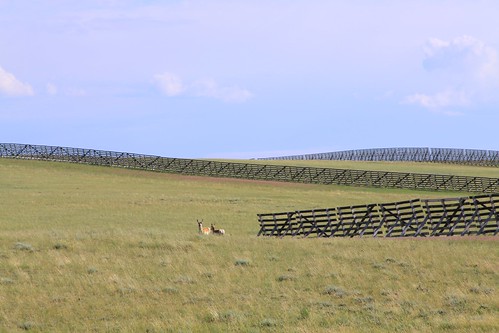
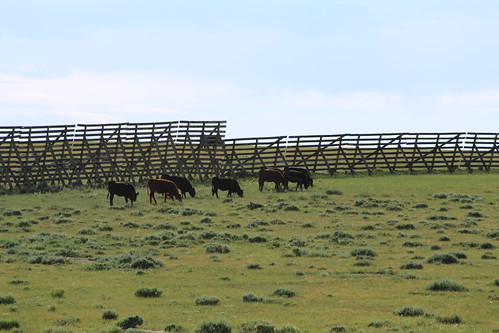
The next few are from around the enormous rail-yard running through Laramie's downtown district:
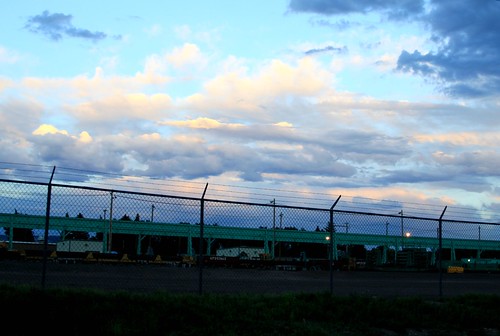
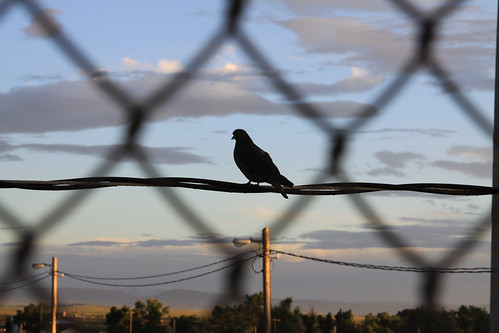
Oh, buck fences. How you continue to beguile and yet horrify me...


And of course, the ubiquitous barbwire fence, the most common sight outside of the town spaces:
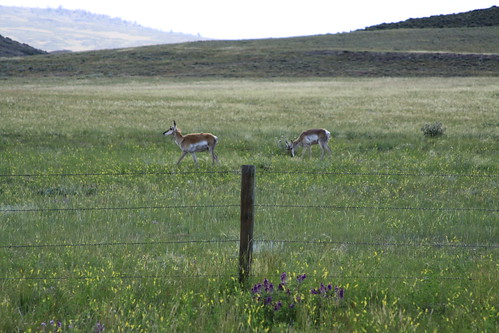

So, I didn't get a really broad survey of fences over my short stay, but here's a few shots of the variety which fences bring to our landscape. Yes, buck fences are included. But they are only one kind of sign in a whole system of signs which impress upon our imaginations. I hope you enjoy!

I will forever have a soft spot for snow fences. Here's a couple more in the off-season:


The next few are from around the enormous rail-yard running through Laramie's downtown district:


Oh, buck fences. How you continue to beguile and yet horrify me...


And of course, the ubiquitous barbwire fence, the most common sight outside of the town spaces:


Labels:
buck fence,
In Pictures,
landscape,
West Laramie,
Wyoming
Monday, November 15, 2010
The Eds, Take 2
So, in 10 Years Later we had an interesting insight into the tense weeks surrounding the tenth anniversary of the Shepard murder. On the one hand, the Boomerang staff did a wonderful five-part series on where Laramie as a community stands a decade after they found their values severely challenged in the national spotlight. They dedicated that bench on the A&S plaza in Matt's memory. We see the LGBT community in Laramie developing a new presence on the campus and keeping dialogue alive. Those were all great things (and you can read about most of them if you search the Boomerang's online archive. Links are on the "Bibiliography" page to the right.)
On the other hand, we also got an unsettling glimpse of a community in deep denial. We saw both intentional and unintentional forgetting of Matt's name and a fear for some kind of permanent change. We saw people who still deeply resented the stigma that the national spotlight cast on the town. And then there was this.
The second editorial in the Boomerang ran on the tenth anniversary of Shepard's death, and it is the editorial that is specifically mentioned in The Laramie Project. It's also the editorial to which Jonas Slonaker tries to respond, but they wouldn't run his letter. For some reason, you can't find the copy for either of the 10th anniversary editorials on the Boomerang website archive even though other editorials are available there, but an hour or so on the microfilm machine right before the library closed yielded my very own copy. Man, I love public research institutions.
There are a few interesting things to note on this second editorial piece, which is entitled "Laramie is a Community, Not a Project." First of all, there's no byline on this, so it seems that the Boomerang was putting this out as its official position rather than just the editor's personal view. The email listed for responses is for the actual publisher, too, rather than just the editor.
Secondly, the amount of snark right at the end where they're pushing the robbery motive is just... well, baffling. But I guess even journalists have a right to have an opinion, and at least it's on the Opinion page. My experience is that small town newspapers are a lot more strident when pushing personal opinion than most, so perhaps I shouldn't be as surprised as I am to see how blunt it is.
But, with that said, this opinion piece is not entirely bad. The first several paragraphs are actually a fairly good summary of the community reactions, and it's useful for that. And the editorial is very right about one thing: Laramie is more tolerant than most other communities in the area. That should be kept in mind. However, I definitely would challenge the publisher about his dismissal of this as the problem of "a few questionable characters." It's not. Those people don't define Laramie exclusively, but they are still a part of who Laramie is, and you can't just reject McKinney and Henderson because they make us feel guilty. Whether we like it or not, Laramie does share some societal guilt for what happened to Matthew Shepard because we are part of the society which shaped them; ignoring that solves absolutely nothing-- and unless we learn to embrace the McKinneys and Hendersons in our communities as a part of who we are and try to transform their hate with love, it's only a matter of time before this happens again.
In any case, the Boomerang's had their say on the matter. And I'll be happy to let the rest of y'all know about it.
On the other hand, we also got an unsettling glimpse of a community in deep denial. We saw both intentional and unintentional forgetting of Matt's name and a fear for some kind of permanent change. We saw people who still deeply resented the stigma that the national spotlight cast on the town. And then there was this.
The second editorial in the Boomerang ran on the tenth anniversary of Shepard's death, and it is the editorial that is specifically mentioned in The Laramie Project. It's also the editorial to which Jonas Slonaker tries to respond, but they wouldn't run his letter. For some reason, you can't find the copy for either of the 10th anniversary editorials on the Boomerang website archive even though other editorials are available there, but an hour or so on the microfilm machine right before the library closed yielded my very own copy. Man, I love public research institutions.
There are a few interesting things to note on this second editorial piece, which is entitled "Laramie is a Community, Not a Project." First of all, there's no byline on this, so it seems that the Boomerang was putting this out as its official position rather than just the editor's personal view. The email listed for responses is for the actual publisher, too, rather than just the editor.
Secondly, the amount of snark right at the end where they're pushing the robbery motive is just... well, baffling. But I guess even journalists have a right to have an opinion, and at least it's on the Opinion page. My experience is that small town newspapers are a lot more strident when pushing personal opinion than most, so perhaps I shouldn't be as surprised as I am to see how blunt it is.
But, with that said, this opinion piece is not entirely bad. The first several paragraphs are actually a fairly good summary of the community reactions, and it's useful for that. And the editorial is very right about one thing: Laramie is more tolerant than most other communities in the area. That should be kept in mind. However, I definitely would challenge the publisher about his dismissal of this as the problem of "a few questionable characters." It's not. Those people don't define Laramie exclusively, but they are still a part of who Laramie is, and you can't just reject McKinney and Henderson because they make us feel guilty. Whether we like it or not, Laramie does share some societal guilt for what happened to Matthew Shepard because we are part of the society which shaped them; ignoring that solves absolutely nothing-- and unless we learn to embrace the McKinneys and Hendersons in our communities as a part of who we are and try to transform their hate with love, it's only a matter of time before this happens again.
In any case, the Boomerang's had their say on the matter. And I'll be happy to let the rest of y'all know about it.
Labels:
10 Years Later,
Laramie,
Matt Shepard,
media,
robbery motive
Friday, November 12, 2010
Laramie in Pictures: Curt Gowdy State Park
East of the Laramie city limits is a vast state park named after Curt Gowdy, a former Wyoming native, UW graduate and sportscaster for the Boston Red Sox. The park is especially notable for its varied landscape ranging from prairie to pink boulder hills to mountain forest. It also sports some of the most awesome twisted trees in the state. It's extremely popular with the locals for camping, four-wheeling, and hiking. On many days, you can see cattle roaming through the back stretches of the park.
Even though this is a space heavily used by humans, in a sense, this is the landscape that probably defines Laramie as a natural space. On my very last day in Laramie I took some pictures of the park's strange, ethereal beauty from the top of a ridge to give you a sample. I hope you enjoy it!

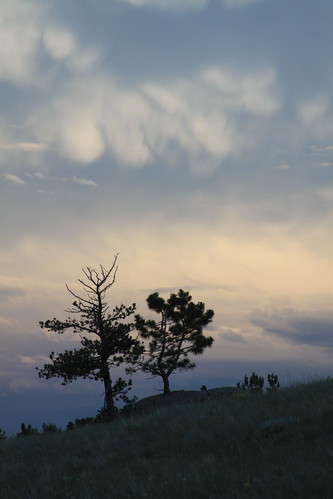
Even though this is a space heavily used by humans, in a sense, this is the landscape that probably defines Laramie as a natural space. On my very last day in Laramie I took some pictures of the park's strange, ethereal beauty from the top of a ridge to give you a sample. I hope you enjoy it!


Labels:
In Pictures,
landscape,
Wyoming
Monday, November 8, 2010
The Eds, Take 1
While I was in Laramie, I didn't get a lot of academic-y stuff done. Most of the people I had hoped to chat with were gone for the July 4th weekend, and after some bad planning and some car troubles, I only had a few short hours to make use of the university library before they closed up for the 4th of July weekend.
But my time in Laramie wasn't a loss by any stretch. I spent a lot of time with my brother Coyote, who let me see this community for a weekend through his eyes, and for which I thank him. I spent a lot of time lost in the wilderness trying to learn how to be alone with myself again. And I got three whole hours in Coe Library, where I spent my time digging in the basement and looking at the microfilm.
And what I found was really interesting. I only had a short time to look at the Boomerang's coverage of the original beating and the ten-year anniversary, but it was extremely revealing, and I'll be talking about that in more detail later. But the best gems I came back with were some editorials from the current Boomerang staff. After 10 Years Later, we all learned about one snarky editorial on their Opinion page; as it turns out, there were two.
The first editorial (which I highly encourage you read) doesn't get a mention in the play from what I remember, and it's pretty interesting. It was entitled "Ten Years Later, It's Time To Move On," and it's a bit of an over-the-top emotional argument about why the community needs to let the specter of Matthew Shepard go. For one, I noticed that this one is actually attributed to the editor personally. She's also asking a legitimate question: why do some stories of murder remain and get memorialized and others don't? That's a great question, actually. What I don't like is using that question to dismiss any attention paid to Shepard.
In the editorial, the editor gives a litany of other murders and tragic deaths which happened in Laramie (of which Cindy Dixon, Russell Henderson's mother, is one) and complains that none of them are given the same recognition. She's not quite right about her examples of forgotten tragedies, however. There was a memorial marker erected at Tie Siding where the members of the cross-country team died (and note the evasive wording in that statement). This white cross stands near the location where the accident occurred. Nothing, however, stands on the ground where Shepard was brutally murdered, not even the fence on which he was tied. One location has a white cross marker to help establish the memory of a tragedy while the other has been wiped clean of all bad memories. I'm not saying that this is a problem per se-- that landowner has the right to have peace on his or her own property-- but it does complicate her point, which the editor tries to paint a little too much in black and white when this is an issue that by definition requires shades of gray.
I also find it interesting that, in her litany of tragedies in her editorial, she chose to skip over Kristen Lamb. That was the tragedy that had so many people in Laramie steaming (her murderer's trial roughly coincided with the Shepard beating) and is often cited as justification for those who resent the media attention over Shepard's death. Perhaps some things run too deep, and too painful, even to be used as ammo by an angry journalist in a newspaper editorial. Maybe there are other tragedies she would like to see remain at rest, and unmentioned.
Anyhow, I guess that would be my main complaint here. Sure, Deb, you're asking a legitimate question, and it's one that I (and many others) are interested in, too. But you're not asking it in order to get an answer. You're simply using it as an excuse to complain about an event that has left Laramie feeling bruised. If you'd stop and explore that question-- why some stories are remembered and others are not-- you might learn something really fascinating about the nature of collective memory and human nature. That's a lot more productive than trying to wish away a memory of an event that stings to remember and isn't going to go away.
Whether we like it or not, Matt will be a part of this community's memory. The only real question, in my mind, is whether or not we incorporate that memory in a positive way or not, and an attitude like yours makes that difficult. And it makes it impossible for everyone to "move on" from this tragedy like you want. No one can "move on" from a story like this until it is confronted and you reconcile yourself to its existence. That's the only kind of positive healing this community can ever have, and if you don't do that, you will continue to be haunted by this memory which will never leave. The more you try to "move on," the longer he's going to be with you.
PHOTO CREDIT:
1) The roadside memorial at Tie Siding, Wyoming, taken from gregor_y's Flickr photostream:
But my time in Laramie wasn't a loss by any stretch. I spent a lot of time with my brother Coyote, who let me see this community for a weekend through his eyes, and for which I thank him. I spent a lot of time lost in the wilderness trying to learn how to be alone with myself again. And I got three whole hours in Coe Library, where I spent my time digging in the basement and looking at the microfilm.
And what I found was really interesting. I only had a short time to look at the Boomerang's coverage of the original beating and the ten-year anniversary, but it was extremely revealing, and I'll be talking about that in more detail later. But the best gems I came back with were some editorials from the current Boomerang staff. After 10 Years Later, we all learned about one snarky editorial on their Opinion page; as it turns out, there were two.
The first editorial (which I highly encourage you read) doesn't get a mention in the play from what I remember, and it's pretty interesting. It was entitled "Ten Years Later, It's Time To Move On," and it's a bit of an over-the-top emotional argument about why the community needs to let the specter of Matthew Shepard go. For one, I noticed that this one is actually attributed to the editor personally. She's also asking a legitimate question: why do some stories of murder remain and get memorialized and others don't? That's a great question, actually. What I don't like is using that question to dismiss any attention paid to Shepard.
In the editorial, the editor gives a litany of other murders and tragic deaths which happened in Laramie (of which Cindy Dixon, Russell Henderson's mother, is one) and complains that none of them are given the same recognition. She's not quite right about her examples of forgotten tragedies, however. There was a memorial marker erected at Tie Siding where the members of the cross-country team died (and note the evasive wording in that statement). This white cross stands near the location where the accident occurred. Nothing, however, stands on the ground where Shepard was brutally murdered, not even the fence on which he was tied. One location has a white cross marker to help establish the memory of a tragedy while the other has been wiped clean of all bad memories. I'm not saying that this is a problem per se-- that landowner has the right to have peace on his or her own property-- but it does complicate her point, which the editor tries to paint a little too much in black and white when this is an issue that by definition requires shades of gray.
I also find it interesting that, in her litany of tragedies in her editorial, she chose to skip over Kristen Lamb. That was the tragedy that had so many people in Laramie steaming (her murderer's trial roughly coincided with the Shepard beating) and is often cited as justification for those who resent the media attention over Shepard's death. Perhaps some things run too deep, and too painful, even to be used as ammo by an angry journalist in a newspaper editorial. Maybe there are other tragedies she would like to see remain at rest, and unmentioned.
Anyhow, I guess that would be my main complaint here. Sure, Deb, you're asking a legitimate question, and it's one that I (and many others) are interested in, too. But you're not asking it in order to get an answer. You're simply using it as an excuse to complain about an event that has left Laramie feeling bruised. If you'd stop and explore that question-- why some stories are remembered and others are not-- you might learn something really fascinating about the nature of collective memory and human nature. That's a lot more productive than trying to wish away a memory of an event that stings to remember and isn't going to go away.
Whether we like it or not, Matt will be a part of this community's memory. The only real question, in my mind, is whether or not we incorporate that memory in a positive way or not, and an attitude like yours makes that difficult. And it makes it impossible for everyone to "move on" from this tragedy like you want. No one can "move on" from a story like this until it is confronted and you reconcile yourself to its existence. That's the only kind of positive healing this community can ever have, and if you don't do that, you will continue to be haunted by this memory which will never leave. The more you try to "move on," the longer he's going to be with you.
PHOTO CREDIT:
1) The roadside memorial at Tie Siding, Wyoming, taken from gregor_y's Flickr photostream:
Labels:
10 Years Later,
commemoration,
Laramie,
media,
memory,
reporting
Friday, November 5, 2010
Laramie in Pictures: Medicine Bow Natural Forest
Back on July third of this year when I was in Laramie, I found my bother Coyote lounging outside of his little apartment, watching the traffic go by. As usual, he looked a little underfed (he prefers to live off of coffee and cigarettes) but nonetheless happy, surrounded by loyal and oddball friends. I'm rather used to his strange, bifurcated life. On the one hand, he sincerely believes he's living life on his own terms; on the other hand, this is not the life he would prefer to live into his forties. When I asked if he had any plans, the first thing he said was he wanted to go ride the Centennial highway into the Medicine Bow National Forest.
While his request surprised me at first (I was expecting a restaurant request), it makes perfect sense for Coyote. In some ways, he's more tied to the land than I am, and his only transportation right now is a borrowed bicycle. He can't ever really get out, get alone and spend some time with nature. And while I dearly love the plains as well, what Coyote really craves are the high places, where the tree lines thin out and the stark rocks of an ancient geology tower over his head. What he craves is the smell of the wind combed by pine trees. So, we hopped in my borrowed car and cruised up past Centennial into the frigid mountain air and threw snowballs at each other the day before Independence Day.
So, here are some pictures from out west of Centennial in the Medicine Bow national forest. I hope you enjoy them (but especially Lake Marie.)
When you get this high, cold and windy, the trees start doing some funny things to adapt. You know, like only growing in the direction of the wind.
These are dog-tooth violets, found just off of the summit. I took this picture of them, and the snowdrift behind them, on July 3rd. Then Coyote and I threw snowballs at each other.
Here we have an extremely bold yellow-bellied marmot hanging out on the white granite boulders around Lake Marie. He was so close to me that I took this without a telephoto.
...and here is tiny Lake Marie, which is so beautiful it leaves me speechless. I hope you have a great day.
While his request surprised me at first (I was expecting a restaurant request), it makes perfect sense for Coyote. In some ways, he's more tied to the land than I am, and his only transportation right now is a borrowed bicycle. He can't ever really get out, get alone and spend some time with nature. And while I dearly love the plains as well, what Coyote really craves are the high places, where the tree lines thin out and the stark rocks of an ancient geology tower over his head. What he craves is the smell of the wind combed by pine trees. So, we hopped in my borrowed car and cruised up past Centennial into the frigid mountain air and threw snowballs at each other the day before Independence Day.
So, here are some pictures from out west of Centennial in the Medicine Bow national forest. I hope you enjoy them (but especially Lake Marie.)
When you get this high, cold and windy, the trees start doing some funny things to adapt. You know, like only growing in the direction of the wind.
These are dog-tooth violets, found just off of the summit. I took this picture of them, and the snowdrift behind them, on July 3rd. Then Coyote and I threw snowballs at each other.
Here we have an extremely bold yellow-bellied marmot hanging out on the white granite boulders around Lake Marie. He was so close to me that I took this without a telephoto.
...and here is tiny Lake Marie, which is so beautiful it leaves me speechless. I hope you have a great day.
Labels:
In Pictures,
landscape,
Wyoming
Wednesday, November 3, 2010
Jackrabbit's angsty blog turns 1 year old today!
Happy Birthday, Jackrabbit Blog!
Exactly one year ago to this day, an angsty, melancholic grad student and former UW undergrad started this blog to get her head on straight. Happy birthday! I feel like I need emo party hats and streamers for the occasion.
And now, one year later, I'm still an angsty, melancholic grad student. I don't know if my head's on any straighter, but I certainly feel like I've learned a lot by blogging in this weird way about myself and The Laramie Project at the same time. If anything it's taught me a lot about how people try to understand themselves through literature. It's also taught me how to loosen up a bit and see where the flex and flow is within a person's self, that there is never really a "stable" sense of identity. We bend and flex with conflict, seeking a resolution; this is how the Lord would mold us. The self, I think, isn't so much a collection of essential memories as a series of tense negotiations.
So-- what have been my highlights so far? There are a few:
Exactly one year ago to this day, an angsty, melancholic grad student and former UW undergrad started this blog to get her head on straight. Happy birthday! I feel like I need emo party hats and streamers for the occasion.
And now, one year later, I'm still an angsty, melancholic grad student. I don't know if my head's on any straighter, but I certainly feel like I've learned a lot by blogging in this weird way about myself and The Laramie Project at the same time. If anything it's taught me a lot about how people try to understand themselves through literature. It's also taught me how to loosen up a bit and see where the flex and flow is within a person's self, that there is never really a "stable" sense of identity. We bend and flex with conflict, seeking a resolution; this is how the Lord would mold us. The self, I think, isn't so much a collection of essential memories as a series of tense negotiations.
So-- what have been my highlights so far? There are a few:
- The Laramie Project doesn't give me nightmares anymore.
- There is a lot of interesting dialogue going on back and forth with TLP, and is freaking fascinating.
- There still is a lot of story left to be told about Laramie itself, and the way it views sexuality, identity, community, and TLP itself is a lot more complicated than we let on.
- I got to post lots of pictures making fun of Fred Phelps. (Yeah, that was fun.)
- I'm getting active both in my faith community and the LGBT community to try and heal some of the rift that exists between them.
PHOTO CREDIT:
Here It Is, originally uploaded by Caveman 92223.
Tuesday, November 2, 2010
Watch "TLP: 10 Years Later" online!
You can actually watch clips from the New York performance of The Laramie Project: 10 Years Later, an Epilogue online!
Tectonic Theater has launched a new website for The Laramie Project with a variety of great things included-- there's going to be community access, it looks like, as well as blogs and photos. But the thing that's particularly exciting for me is that you can see eight minutes of the Lincoln Center performance online. That means I have something I can actually cite from! I can talk about 10 Years Later in a meaningful fashion-- sort of.
If you wanted to see the sequel but couldn't, now you can have a taste of it online. The performance recorded here includes some post-performance discussion as well. I don't know if the plan is to keep this up, so visit while you can...
Tectonic Theater has launched a new website for The Laramie Project with a variety of great things included-- there's going to be community access, it looks like, as well as blogs and photos. But the thing that's particularly exciting for me is that you can see eight minutes of the Lincoln Center performance online. That means I have something I can actually cite from! I can talk about 10 Years Later in a meaningful fashion-- sort of.
If you wanted to see the sequel but couldn't, now you can have a taste of it online. The performance recorded here includes some post-performance discussion as well. I don't know if the plan is to keep this up, so visit while you can...
Labels:
10 Years Later,
links,
theater
The bench: Matthew Shepard's memorial and its landscape

In The Laramie Project: 10 Years Later, we learned about the Shepard memorial bench on the University of Wyoming campus, which is parked at the front of the Arts and Sciences building. (That's A&S there at the right.) In addition to holding the university's main concert hall venue, A&S is also home to the Political Science department (Matt's university home) and a lot of administration.
A&S holds a privileged location on campus, too: of all the enormous buildings which ring Prexy's Pasture, the functional center of the university, A&S occupies the entire western end, and the pasture in front of it sometimes feels like a grassy mall leading up to its front steps. (The bench is basically right behind that maroon van.)
So, without any further ado, here's the bench, with a closeup of the plaque:
It really is a sweet gesture, I think. It gives Matt an important place on campus to permanently commemorate his life, and it's both right in front of the A&S college and in a high traffic area when the A&S auditorium is being used. I especially like the positive message of the plaque. It commemorates Matt, not as a victim, but one who made a positive impact. After so much bad press after his murder, I think reminding the campus that Matt was a person, and one who has made a positive difference on everyone there is important. And, doing it on a piece of furniture means that people will actually interact with the memorial is a great way to set the right tone. This isn't a cumbersome monolith that forces an ambivalent memory upon a campus still covering its scars. Rather, it invites remembrance to those who stop to enjoy its presence.
So, yes, I rather like the placement and wording of the Shepard memorial, but if someone took a brisk walk around camps and even around town, she would realize that Shepard's commemoration is hardly unique. For instance:
Here we have an identical bench dedicated to former UW president Phil Dubois and donated by the Trustees. It's located a little farther up Prexy's pasture, on the side nearest to A&S.
This one is dedicated to former president Dubois' mother (complete with crow droppings from the flock of crows roosting on A&S):
This one was paid for by the Dubois family, as she passed away in 1999. The former Mrs. Dubois has her bench only about seventy-five feet from the plaza in front of A&S, sort of between A&S and Merica Hall just to the south.
There are lots of these benches around campus, and I'm willing to bet at least a dozen of them have memorial plaques, to everyone from beloved former professors to admins. (I think one I saw was for a donor, but I have no idea, really.) So, at this point I bet you're thinking, "Wow, the Shepard memorial bench isn't unique at all!" I'm afraid so-- in fact, these benches are not just a campus phenomenon. Here's one dedicated to Cal Rerucha, the former DA who prosecuted both McKinney and Henderson in 1999-2000:
You can tell from the picture that these are not the same kind of benches; I think they're part of a city rather than a university project. These benches, which sit on the north (Ivinson Avenue) side of the county courthouse, are not really reserved as memorial markers, judging by the presence of a bench with a plaque for Wal-Mart stores (I think it's the one just past the upper left-hand corner of this photo. Rather, they're more like tiny billboards. I think that's the point of the Reruchas' plaque on this one: it simply names himself and his wife as "attorneys at law." What better place for a lawyer to hang out his shingle than in front of the courthouse, eh?
So, I guess there are two different ways to look at Matt's bench in the context of the surrounding environment. The negative one might complain that Matt's memorial isn't really all that special, and the only way they managed to get on campus was to sneak it in under a campus beautification project. It's almost like saying, "Okay, we'll actually let you mark the campus with his memory, but his memorial can't draw attention to itself..." Honestly, I suppose that's how I felt about it when I first wandered about the campus that afternoon, but I think that there's a second, positive way to think about the bench.
What helped me change my mind? On the way back to my car one afternoon, I was walking back towards Prexy's in the direction of my car when I saw this fellow chatting on the phone:
Seeing this student casually tracing his hands down the bench as he talked on his phone made me stop to think: what are the chances that this kid will look down and see the plaque? Maybe he will, but he might not, either. Even though this student's act of remembrance isn't what most people think when they try to picture commemoration, this interaction with Shepard's memory on his own terms shows how the bench incorporates Matthew's memory into the very fabric of UW's landscape. This is unlike a normal memorial marker, like the one for the Challenger explosion on the west side of campus. When I lived on campus, the Challenger astronauts' stone and bronze marker only really got any attention when someone used it as a hole for Frisbee golf. Then some of us felt a little queasy about the idea of slapping the Challenger astronauts in the face with a golf disc, and eventually we moved the hole. After that, none of us really even noticed it anymore.
In contrast to the Challenger memorial, Matt's bench gets a lot of daily interaction because it's designed for interactive experience. As students look for a quiet spot to read and bask in the sun, they seek it out. And, since it's part of a larger network of memorial benches to other beloved people, the bench presents who he really was to the campus: someone who was a part of the UW community and whose life has indelibly left its mark on us all.
One evening after photographing Old Main, I stopped to have a seat on the memorial bench myself. As I sat in the lengthening shadows of A&S, I could gaze upward to its highest floors dressed in sandstone, or the huge, stately pines which dominate the green spaces on the north side. To my left was Prexy's Pasture, with its diamond pattern of walkways leading to the family/unity statue in the center, and the flagpoles for the university, state, and nation beyond. It's a good place to sit and ponder, I decided, and as students do that, they meet with a little piece of Shepard's life. And every time we do, we remember a little piece of Matt.
Labels:
commemoration,
landscape,
Matt Shepard,
University of Wyoming
Monday, October 25, 2010
Class lines on the front lines, part 3: Why facts can't kill prejudice
[A note from Jackrabbit: after spending the morning counting <span> tags and <div> separators, I finally managed to find the problem which made half my post disappear. You can now read the whole thing!]
In my last post, we looked at how a couple of really outraged west Laramie residents schooled the AP reporters who portrayed the community as a poverty-class wasteland of despair. Both wrote letters to the editor of the Boomerang to counteract both the poverty narrative of West Laramie and the notion that Matt's murderers were typical of the people who lived there.
While I had that little thrill from seeing ordinary Laramie citizens taking on "the man," so to speak, something didn't seem right-- and the more I thought about the AP article and the local response it just didn't feel right. But after these letters rattled about in my head for a couple months, I finally realized what was bugging me: what's the point of attacking the reporters anyhow? They aren't the ones who made this story up.
 In the month following Shepard's death, locals and former residents attacked that article as everything from "a putdown" to "asinine." My personal favorite was the person who told them to "lose the finger paints." But none of that changes the fact that the form of that story wasn't an AP construction. It's ours. Sure, those AP hacks should be held accountable for their lazy reporting and filling in details which weren't true, but the narrative driving that portrayal is a local product. It's like slapping that little kid who points out that the emperor isn't wearing any clothes so you can keep pretending that there's no parade going on.
In the month following Shepard's death, locals and former residents attacked that article as everything from "a putdown" to "asinine." My personal favorite was the person who told them to "lose the finger paints." But none of that changes the fact that the form of that story wasn't an AP construction. It's ours. Sure, those AP hacks should be held accountable for their lazy reporting and filling in details which weren't true, but the narrative driving that portrayal is a local product. It's like slapping that little kid who points out that the emperor isn't wearing any clothes so you can keep pretending that there's no parade going on. In short, all these reporters did was to link two firebomb narratives already present in Laramie-- the Shepard beating and the West Laramie class divide-- and do a really lousy job of it. So when the outrage started, sure, it gave people an opportunity to stick up for the home crowd, but it goes no farther. They can't exorcise this story from Laramie because it would also mean confronting it head-on.
I guess what I'm saying is that you can never really succeed in attacking a false narrative about power-- whether it's between classes, between races, or genders-- by proving it's not true; you can only attack a powerful narrative by exposing why it exists, what fears it elicits, and who needs that story to be true. I'd like to spend a little bit of time thinking about that disconnect in the West Laramie story, and why it's still floating around. But that also means I'm going to go all Marxist/Lacanian analytical on you and pull out some Slavoj Žižek. You've been duly warned!
Labels:
class conflict,
Hooray for Žižek,
Laramie,
narrative,
place,
reporting,
West Laramie
Subscribe to:
Posts (Atom)



